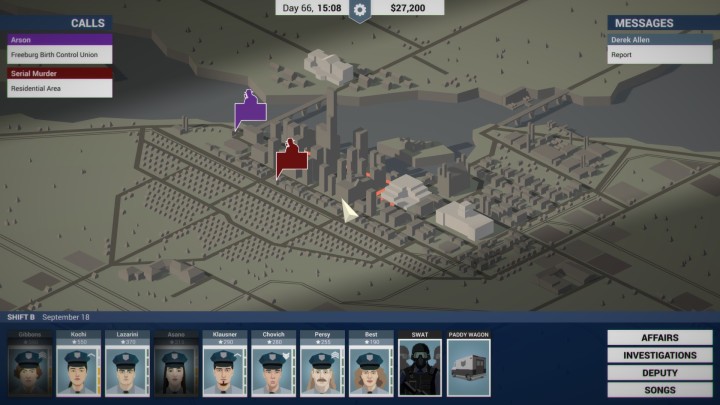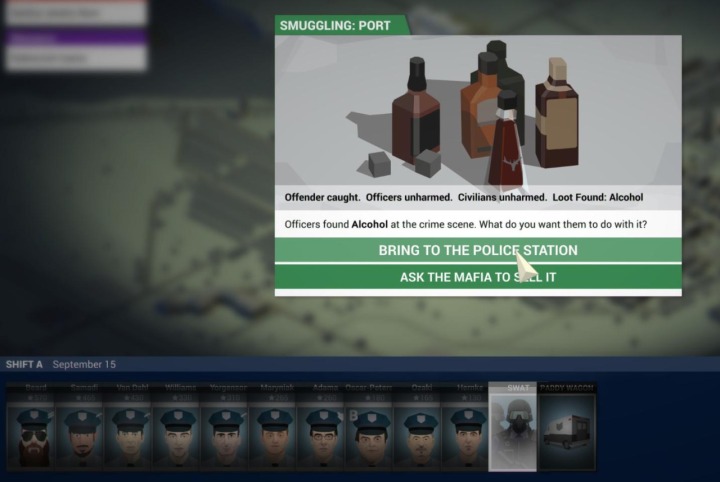For once, here comes a cross-review of two almost different type of games I recently finished. The first one is a famous big budget GTA-style followup of Mafia II, the second an isometric low budget sim-type game, both finished in approximatively 30 hours.
Gameplay
Mafia III gameplay is not much different from previous Mafia game – or from any other GTA-like game. It (fighting, driving) is nicely done though not innovative. There is a “simulation” setup option for the driving experience but it will still be arcade nonetheless. Most cars really behave the same, no matter how different they appear to be, and laws of physics rarely applies. You can go off road at full speed, somehow you do not loose grip; you can hit vehicules repeatdly with not much damage to your car. Strangely enough, you can loose some parts of the car (trunk, for instance), you can scratch the paint, but the body panels are never bent, no matter how many times and how hard you hit obstacles.

Here you have the example of a car that just had a major frontal collision with another car, both at full speed. The trunk was lost but the rest is perfectly in shape. This is something strange from a game with graphics that precise to have a however completely irrealistic damage setting. As a matter of fact, it is not worth it to try to drive any car properly since you can hit whatever wall at high speed with no effect. It is just much more efficient to drive on the limit all the time, which would, in real life, get you killed in half a hour. This makes the driving sequences quite unchallenging – boring, at some point.
How police reacts to you is quite odd too. Apparently it is fine to almost ran over cops at high speed. But if you just bump one of their cars at 7 mph, they’ll shoot to kill. Citizens also tend to report crimes by calling the police: you can kill them to prevent it but there no way just to dissuade them to. A bit odd.
This Is the Police gameplay is minimalistic. You are presented with an isometric view of a city and cards that represents the coppers available. Calls or missions come in an you have to send coppers accordingly. The game is not a sandbox but a story: missions are scripted, the same events will always occur on the same day, so the replay value of the game is relatively low. The game has been critized since some choices you do have no decisive impact on the game outcome. For instance, you cannot not work, even a little, with the mob, otherwise you get killed. It can be disappointing from a sandbox game perspective but, considering it as a story that unfold, it is fine by me.
The game is not a sandbox but a story: missions are scripted, the same events will always occur on the same day, so the replay value of the game is relatively low. The game has been critized since some choices you do have no decisive impact on the game outcome. For instance, you cannot not work, even a little, with the mob, otherwise you get killed. It can be disappointing from a sandbox game perspective but, considering it as a story that unfold, it is fine by me.

I am actually a bit more concerned by the fact that coppers on the beat are managed as if they were ambulances or fire trucks: in real life, police patrols are patroling, not waiting for the next call at the station. In This Is the Police, coppers are either on a mission or waiting at the station. The game would make more sense if, on each shift, patrols were, at least, assigned a sector. Distance to cover would then matter when assigning missions.
There are also cases to solve: image puzzles. I must say that they are not all tremendously logical. But the concept is interesting.
Ambiance, dialogues, story – and the racial issue
These are the strong points of both games. Tied by the genre, you won’t be surprised like hell by plots. But the dialogues are well written and well enacted.

In both, racial issue takes a central place. In Mafia II, you can hear to often racial slurs from NPCs, Kotatu summarized the debate that ensued. In This Is the Police, you are often presented by instructions as follows:

Maybe it is not entirely surprising to see games that focused on racial issues while, at the same time of release of these games, from USA to France, every day street coppers are killed because they are so and are, at the same time, accused of being hostiles to black or arabs, while these, in both countries, are overly dominant in street crime.
And, similarly, even though the racial issue take a central place in these game, it does not matters truly. The main character of Mafia III kills for his own revenge and profit, he made friend with an haitian gang, none mix, they are all opposing others for their own benefit. The major or the chief of police in This Is the Police do not care either. The race is just a color given to selfish greed-driven or powertrip-driven hostility. It is not the root of evil but definitely a taint.
After singing “Police on my back” in 1968, in 1970, The Equals were telling us about the kids in the future : “They ain’t got no country They ain’t got no creed People won’t be black or white The world will be half-breed. You see the Black Skin Blue Eyed Boys“. In 2016, they could not have been more wrong.
